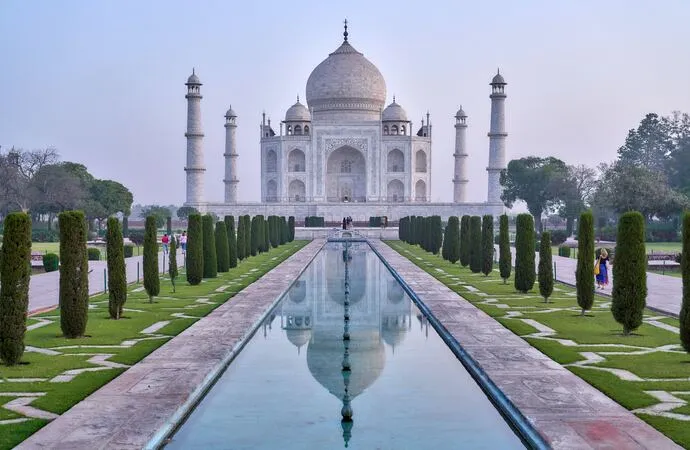The Taj Mahal.

The Taj Mahal is a structure that spans time and can arouse the strongest of emotions. It is located in the center of Agra, India, tucked along the banks of the Yamuna River.
The Taj Mahal, regarded as one of the most famous architectural wonders in the world, is more than just a monument; it is a symbol of love, human creativity, and history.
The Taj Mahal, a UNESCO World Heritage monument, has fascinated tourists and history buffs for centuries as a timeless representation of love and beauty.
Significance in History and Culture.
The Taj Mahal is a tribute to the magnificence of the Mughal Empire in addition to being a symbol of unwavering love. Thousands of artisans and craftsmen worked diligently to create this architectural marvel during its development. The Taj's architecture reflects the cultural diversity of its era by fusing Persian, Islamic, and Indian influences. Visitors to the Taj are taken back in time to a period of wealth and artistic brilliance when beauty was valued above all else.
Marvel of Architecture.
Persian, Islamic, and Indian influences are perfectly incorporated into the building of the Taj. A beautiful aesthetic masterpiece is created by the building's immaculate white marble, delicate calligraphy, and symmetrical gardens.
Dawn and sunset enhance the Taj's otherworldly beauty by bathing it in a bizarre, constantly shifting light.
The Complex Details.
All who visit The Taj Mahal are fascinated by its rich features. The Quranic calligraphy adorns the surfaces of the marble façade, which is decorated with beautiful floral and geometric motifs.
Shah Jahan and Mumtaz Mahal's remains are housed inside a gleaming mausoleum. Every visit is different due to the building's almost magical aspect added by the movement of light and shadow.
Garden of Charbagh.
The Charbagh, a Persian-style garden, encircles the Taj Mahal. It represents the paradise garden depicted in Islamic tradition and is divided into four sections by water channels. Visitors can enjoy the Taj's reflection in the middle pool as they stroll through the symmetrical garden, producing a magnificent mirror image.
The Variable Colours.
The Taj Mahal's relationship with natural light is among its most alluring characteristics. It has a delicate pinkish colour at daybreak and an orange blush at sunset. Observing these alterations gives the visit a magical quality.
Maintenance and Conservation.
The Taj Mahal's flawless beauty needs to be preserved, which is a big job. The conservation of the area has faced difficulties due to pollution and the sheer number of visitors.
Authorities have taken steps to conserve this national asset, including limiting the number of daily visitors and establishing eco-friendly programmes to lessen its environmental impact. These initiatives are crucial if we want future generations to be able to admire this magnificent structure.
Conclusion.
Visiting the Taj Mahal is a journey through time and love, not merely a vacation experience.
Its stunning architecture, extensive history, and power to arouse strong emotions are what makes it so alluring. Wanderers, artists, and lovers are still moved by the Taj Mahal, which serves as a constant reminder of the strength that beauty and love have.
You can't help but be moved as you stand in front of this famous structure by the Taj Mahal's unwavering devotion and timeless beauty. It is a treasure that belongs to the entire globe, not just India.


